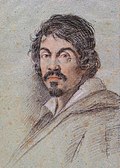Fil:Caravaggio.emmaus.750pix.jpg

Opprinnelig fil (1 203 × 850 piksler, filstørrelse: 173 KB, MIME-type: image/jpeg)
Denne filen er fra Wikimedia Commons og kan brukes av andre prosjekter. Beskrivelsen fra filbeskrivelsessida vises nedenfor.

|
Denne filen er nå foreldet og erstattet av File:1602-3 Caravaggio,Supper at Emmaus National Gallery, London.jpg. Vær vennlig og bruk den andre filen. NB: Denne filen vil ikke bli slettet med mindre den uttrykkelig blir nominert til sletting.
|

|
Beskrivelse
| Caravaggio: Måltidet i Emmaus
|
||||||||||||||||||||||||||||
|---|---|---|---|---|---|---|---|---|---|---|---|---|---|---|---|---|---|---|---|---|---|---|---|---|---|---|---|---|
| Kunstner |
artist QS:P170,Q42207 |
|||||||||||||||||||||||||||
| Tittel | ||||||||||||||||||||||||||||
| Objekttype |
maleri |
|||||||||||||||||||||||||||
| Sjanger |
religiøs kunst |
|||||||||||||||||||||||||||
| Beskrivelse | ||||||||||||||||||||||||||||
| Avbildede personer |
Jesus Kristus |
|||||||||||||||||||||||||||
| Dato |
mellom 1601 og 1602 date QS:P571,+1601-00-00T00:00:00Z/8,P1319,+1601-00-00T00:00:00Z/9,P1326,+1602-00-00T00:00:00Z/9 |
|||||||||||||||||||||||||||
| Medium | maleri | |||||||||||||||||||||||||||
| Dimensjoner |
høyde: 55 in (139,7 cm); bredde: 77 in (195,5 cm) dimensions QS:P2048,55U218593 dimensions QS:P2049,77U218593 |
|||||||||||||||||||||||||||
| Samling |
institution QS:P195,Q180788 |
|||||||||||||||||||||||||||
| Museumsnummer |
NG172 (National Gallery) |
|||||||||||||||||||||||||||
| Objekthistorikk |
commissioned by Ciriaco Mattei in 1601-02 |
|||||||||||||||||||||||||||
| Merknader | The focal point of this picture is a beardless Jesus. Picture prepared for Wikipedia by Adrian Pingstone in April 2003. | |||||||||||||||||||||||||||
| Referanser |
|
|||||||||||||||||||||||||||
| Autoritetsregister | ||||||||||||||||||||||||||||
| Kilde/Fotograf | http://www.kfki.hu/~arthp/html (Web Gallery of Art). http://en.wikipedia.org/wiki/Image:Caravaggio.emmaus.750pix.jpg | |||||||||||||||||||||||||||
Lisensiering
|
This is a faithful photographic reproduction of a two-dimensional, public domain work of art. The work of art itself is in the public domain for the following reason:
The official position taken by the Wikimedia Foundation is that "faithful reproductions of two-dimensional public domain works of art are public domain".
This photographic reproduction is therefore also considered to be in the public domain in the United States. In other jurisdictions, re-use of this content may be restricted; see Reuse of PD-Art photographs for details. | |||||
Bildetekster
Elementer som er med i denne fila
motiv
image/jpeg
b4468bc6eeae1c2146963c173479f8273f5508da
177 375 byte
850 piksel
1 203 piksel
Filhistorikk
Klikk på et tidspunkt for å vise filen slik den var på det tidspunktet.
| Dato/klokkeslett | Miniatyrbilde | Dimensjoner | Bruker | Kommentar | |
|---|---|---|---|---|---|
| nåværende | 14. aug. 2007 kl. 10:21 |  | 1 203 × 850 (173 KB) | wikimediacommons>Argento | same source but bigger |
Filbruk
De følgende 2 sidene bruker denne filen:
Metadata
Denne filen inneholder tilleggsinformasjon, sannsynligvis lagt til av digitalkameraet eller skanneren som ble brukt til å lage eller digitalisere det.
Hvis filen har blitt forandret fra utgangspunktet, kan enkelte detaljer være unøyaktige.
| JPEG-filkommentar | CARAVAGGIO
(b. 1571, Caravaggio, d. 1610, Porto Ercole) Supper at Emmaus 1601-02 Oil on canvas, 139 x 195 cm National Gallery, London The gospel according to St Luke (24:13-32) tells of the meeting of two disciples with the resurrected Christ. It is only during the meal that his companions recognize him in the way he blesses and breaks the bread. But with that, the vision of Christ vanishes. In the gospel according to St Mark (16:12) he is said to have appeared to them "in an other form" which is why Caravaggio did not paint him with a beard at the age of his crucifixion, but as a youth. The host seems interested but somewhat confused at the surprise and emotion shown by the disciples. The light falling sharply from the top left to illuminate the scene has all the suddenness of the moment of recognition. It captures the climax of the story, the moment at which seeing becomes recognizing. In other words, the lighting in the painting is not merely illumination, but also an allegory. It models the objects, makes them visible to the eye and is at the same time a spiritual portrayal of the revelation, the vision, that will be gone in an instant. Caravaggio has offset the transience of this fleeting moment in the tranquillity of his still life on the table. On the surfaces of the glasses, crockery, bread and fruit, poultry and vine leaves, he unfurls all the sensual magic of textural portrayal in a manner hitherto unprecedented in Italian painting. The realism with which Caravaggio treated even religious subjects - apostles who look like labourers, the plump and slightly feminine figure of Christ - met with the vehement disapproval of the clergy.
Author: CARAVAGGIO Title: Supper at Emmaus Time-line: 1551-1600 School: Italian Form: painting Type: religious |
|---|


